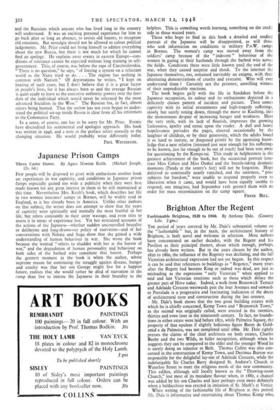Japanese Prison Camps FEW people will be disposed to greet
with enthusiasm another book on experiences in war captivity, and conditions in Japanese prison camps especially gained too wide a publicity when they were first made known for any great interest in them to be still maintained at this time. Nevertheless Mrs. Keith's book, which describes her life in two women internees' camps in Borneo, will be widely read in England, as it has already been in America. Unlike other authors on this subject, the writer does not attempt to show that the years of captivity were spiritually and mentally the most fruitful in her life, but refers constantly to their utter wastage, and even tries to assess it in terms of experience lost. Yet her restrained accounts of the actions of the Japanese—whether sudden uncontrolled brutality or deliberate and long-drawn-out policy of starvation—and of her conversations with Nekata and Suga show that she gained a wide understanding of human behaviour in war. She wrote the book because she wanted " others to shudder with her at the horror of war," and the degradation of human personality and behaviour on both sides of the barbed wire constitute that horror. Perhaps the greateit moment in the book is when the author, whose supreme reason for continuing the struggle against disease, hunger and cruelty was that her son George might live for a happier future, realises that she would rather he died of starvation in the camp than live to imitate the Japanese in their brutality to the
helpless. This is something worth learning, something on the credit side in those wasted years. .
Those who hope to find in this book a detailed and studied portrait of the Japanese will be disappointed, as will those who seek information on conditions in military P.o.W. camps in Borneo. The women's camp was moved away from the soldiers' camp because of the " indecent " behaviour of the women in gazing at their husbands through the barbed wire across the fields. Conditions there were little known until the end of the war, when they caused surprise and shock. To the internee the Japanese themselves, too, remained inevitably an enigma, with their alternating demonstrations of cruelty and restraint. Who will ever understand them ? Certainly not the prisoner, unwilling witness of their unpredictable reactions.
The book begins gaily with the life in Sandakan before the Japanese occupation, its colour and its enthusiasms depicted in a delicately chosen pattern of incident and picture. Then comes captivity with its initial resentments and high-tragedy sufferings, slowly but surely toning down, through the move to Kuching, into the monotonous despair of increasing hunger and weakness. Here the very style, with its lack of flourish, impresses the growing listlessness, apathy and ennui upon the reader. A dull and heavy hopelessness pervades the pages, cheered occasionally by the laughter of children, or by their generosity, which the adults found it so hard to imitate, or deepened grimly by the agonising know- ledge that a near relative (interned just near enough for his sufferings to be known, just far enough to be out of reach) had been sent away for questioning by the Kempi-tai. This study in helplessness is the greatest achievement of the book, but the occasional portrait (con- trast Miss Cohen and Miss Osaka) and the breath-taking dramatic moments (Panda at the sentry's feet) will not be forgotten. Hope deferred so continually nearly vanished, and the internees, " poor subjects for freedom," were unable to respond properly even to liberation when it came, and would have been equally unable to respond, one imagines, had September a ith greeted them with an order for mass extermination on the camp square.
FRANK BELL.


































 Previous page
Previous page